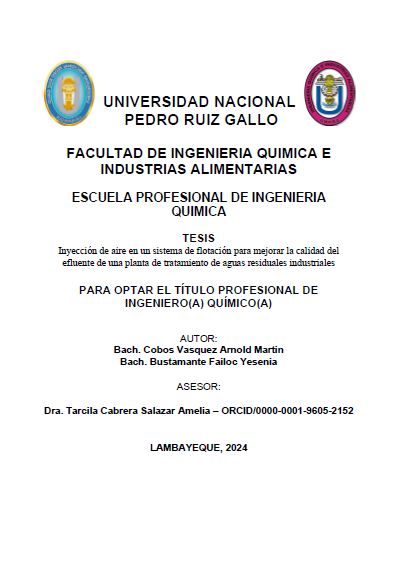Inyección de aire en un sistema de flotación para mejorar la calidad del efluente de una planta de tratamiento de aguas residuales industriales

Fecha
2024-08-27Autor
Cobos Vasquez, Arnold Martin
Bustamante Failoc, Yesenia
Metadatos
Mostrar el registro completo del ítemResumen
El presente trabajo de investigación se realizó con la finalidad de determinar el efecto
generado al implementar una bomba de flujo multifásico que disuelve el aire directamente
del sistema de tratamiento y así se logren reducir los parámetros establecidos para el
vertimiento de aguas industriales a la red de alcantarillado, para lo cual se usó una bomba de
flujo multifásico EDUR. La metodología consistió en realizar un análisis experimental en el
cual se compararon los resultados de la DBO, DQO, SST, SS, obtenidos antes de la
implementación de la propuesta y los resultados logrados con la implementación del nuevo
sistema, para lo cual cada parámetro siguió un análisis diferente, donde intervinieron equipos
como el Bod Track II, espectrofotómetro HACH DR 3900, termo reactor DQO DRB 200,
conos Imhoff, entre otros. Como resultado se obtuvo que para la DBO hubo un aumento de
eficiencia de 92.84 % a 93.29%, para la DQO un aumento de 92.83 % a 93.14 %, y para los
SST, y SS, un aumento de 70.38 % a 83.23 % y 96.9 % a 99.18 % respectivamente. The present research work was carried out with the purpose of determining the effect
generated by implementing a multiphase flow pump that dissolves the air directly from the
treatment system and thus reduces the parameters established for the discharge of industrial
water to the sewage network., for which an EDUR multiphase flow pump was used. The
methodology consisted of carrying out an experimental analysis in which the results of the
BOD, COD, TSS, SS, obtained before the implementation of the proposal and the results
achieved with the implementation of the new system, for which each parameter followed a
different analysis, which involved equipment such as the Bod Track II, HACH DR 3900
spectrophotometer, DRB 200 COD thermo reactor, Imhoff cones, among others. As a result,
it was obtained that for BOD there was an increase in efficiency from 92.84% to 93.29%,
for COD an increase from 92.83% to 93.13%, and for TSS and SS, an increase from 70.38%
to 83.23% and 96.9%. % to 99.18% respectively.
Colecciones
- Ingeniería Química [202]







